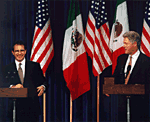
|
 |

|
|
U.S.-Mexico Trade and Economic Relations As a result of dramatically increased trade under the North American Free Trade Agreement (NAFTA), Mexico has become the second largest market for American exports, surpassing Japan. During the first five years of NAFTA, U.S. merchandise exports to Mexico grew by 92%, from $42 billion in 1993 to a projected $79 billion last year. Projected full-year 1998 trade between Mexico and the United State will total $174 billion. Increased sales to Mexico has meant more U.S. jobs. Exports to Mexico in 1998 supported almost one million American jobs, up over 300,000 jobs from 1993. And most of the exports and new job opportunities are in the manufacturing sector. Having Mexico as a reliable, growing trading partner has helped cushion both economies from the ill effects of recent global financial market turmoil. In the first eleven months of 1998, U.S. exports to Mexico expanded by 11%, while total U.S. exports fell by 1% during the same period. Mexican exports to the United States rose 10% last year while exports to other countries fell nearly 9%. Even as growth in many Asian markets has slowed, real GDP in the United States was up 3.9% in both 1997 and 1998. And sales to Mexico alone accounted for nearly one-fifth of the overall growth in U.S. exports worldwide between 1993 and 1998. During 1998, Mexico's economy continued to be among the strongest in Latin America, growing at 4.6% for the year. Mexico's strong performance as a market for U.S. goods owes much to its sound macroeconomic policies, which won back investor confidence after the December 1994 peso devaluation. The United States lent Mexico a total of $12.5 billion in 1995. Mexico finished repaying the loan in full by January 1997, more than three years ahead of schedule. Under the leadership of President Zedillo, Mexico has implemented three rounds of fiscal cuts totaling $4 billion (1% of GDP) to compensate for lost oil revenues as a result of a sharp drop in the world price of oil. Oil revenues account for roughly one-third of government revenues. As a result of these sound measures, Mexico's fiscal deficit for 1998 is expected to close at 1.4% of GDP, less than many major economies around the world. Meanwhile, privatization and economic liberalization have opened new opportunities for U.S. investment in Mexico's railroads, ports, banks, and airports. Finally, a new initiative to open the state-dominated electricity sector to private ventures holds great promise for future cross-border sales or investment. | ||
![]()
To comment on this service,
send feedback to the Web Development Team.
![[White House icon]](/New/images/home_pin.gif)
![[Help Desk icon]](/New/images/help_pin.gif)